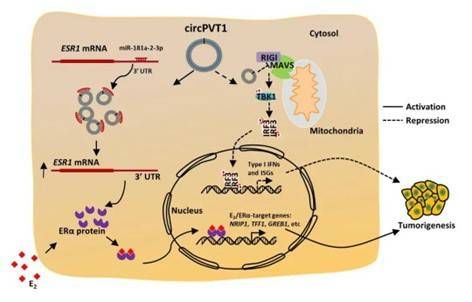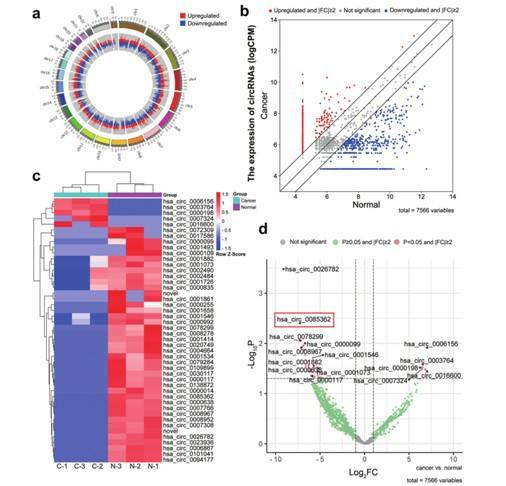Circular RNA is a new endogenous non-coding RNA (ncRNA), which is a new member of the non-coding RNA family with great research potential after microRNA (miRNA) and long noncoding RNA (IncRNA). More and more studies have shown that circular RNAs have the characteristics of rich variety, stable structure, sequence conservation, and cell or tissue-specific expression. Additionally, previous studies have shown that cyclic RNA is associated with diabetes, nervous system disease, cardiovascular diseases, cancer and other diseases, so it has important research value. In addition, the widespread expression of cyclic RNA and disease regulation mechanisms make it a functional biomarker and therapeutic target for various diseases.
Targeted circular RNA Provides Strategies for breast cancer Treatment
Breast cancer is the cancer with the highest incidence rate and mortality rate among women in the world, which seriously threatens women's health. Estrogen receptor (ER)-positive subtype of breast cancer accounts for around 70% of all breast cancer subtypes. One of the important initiating factors is the disturbance of estrogen (17-b-estradiol, estradiol, E2). Researchers report that circPVT1, a circular RNA generated from the lncRNA PVT1, is highly expressed in ERa-positive breast cancer cell lines and tumor samples and is functionally important in promoting ERa-positive breast tumori-genesis and endocrine therapy resistance. Sequencing analysis of circPVT1 using RNA seq showed that it acts as a competing endogenous RNA (ceRNA) to sponge miR-181a-2-3p, promoting the expression of ESR1 and downstream ERa-target genes and breast cancer cell growth. In addition, circPVT1 disrupts the formation of the RIGI-MAVS complex by interacting with MAVS, inhibits the activation of the downstream type I interferon signaling pathway of MAVS, and promotes immune escape of tumor cells. Taken together, this study demonstrated that circPVT1 can work through both ceRNA and protein scaffolding mechanisms to promote cancer. Thus, circPVT1 may serve as a diagnostic biomarker and therapeutic target for ERa-positive breast cancer in the clinic.
 MCF7 cells were transfected with control siRNA or two individual siRNAs specific against circPVT1 followed by RNA-seq.
MCF7 cells were transfected with control siRNA or two individual siRNAs specific against circPVT1 followed by RNA-seq.
 Functional and molecular mechanism pattern of cyclic RNA circPVT1 in promoting the development of breast cancer.
Functional and molecular mechanism pattern of cyclic RNA circPVT1 in promoting the development of breast cancer.
Mechanism of circular RNA sequencing assisting in esophageal squamous cell carcinoma
Circular RNA plays an important role in many cancers such as esophageal squamous cell carcinoma (ESCC), but the exact function of most circular RNAs is still unclear. Researchers detected significant downregulation of circTRPS1-2 in ESCC based on high-throughput sequencing of three pairs of ESCC tissue and adjacent normal tissue, followed by PCR validation with another 30 tissue pairs. The circRNA results obtained from sequencing revealed that 2685 cyclic RNAs were upregulated in cancer, while 4881 cyclic RNAs were downregulated in cancer. The median overall survival time (13 months) of ESCC patients with circTRPS1-2 expression lower than the median level of the sample was significantly shorter than those with circTRPS1-2 expression higher than the median level (36 months). Overexpression of circTRPS1-2 significantly reduced the vitality and proliferation of ESCC cells, as well as the migration ability of ESCC cells. Knocking out circTRPS1-2 has the opposite effect. Conversely, knocking down circTRPS1-2 using short interfering RNA promoted cell proliferation and migration. Similar results were observed in mice bearing K150 xenografts in which circTRPS1-2 was overexpressed or knocked down. In general, this study combined with cyclic RNA sequencing, cyclic RNA qRT PCR, RIP-PCR, RNA pull down and other technologies to prove that circTRPS1-2 regulates the production of ribosome and plays an anti-tumor role by interacting with ribosome protein, and explore the role of circTRPS1-2 as a potential prognostic biomarker and therapeutic target in ESCC.
 Identification of circTRPS1-2 through high-throughput sequencing of ESCC tissues
Identification of circTRPS1-2 through high-throughput sequencing of ESCC tissues
The latest progress in the field of cyclic RNA research has revealed the core content of cyclic RNA biogenesis and biology. The study of circular RNA has brought us many surprising discoveries, which means that circular RNA has important significance in biology and pathological biology. In the future, this technology will reveal more biological mysteries for us.
References:
-
Kristensen, Lasse S et al. "The biogenesis, biology and characterization of circular RNAs." Nature reviews. Genetics vol. 20,11 (2019): 675-691.
- Yi, Jia et al. “CircPVT1 promotes ER-positive breast tumorigenesis and drug resistance by targeting ESR1 and MAVS." The EMBO journal vol. 42,10 (2023): e112408.
- Zhao, Renchang et al. “Circular RNA circTRPS1-2 inhibits the proliferation and migration of esophageal squamous cell carcinoma by reducing the production of ribosomes." Cell death discovery vol. 9,1 5. 12 Jan. 2023.
For research purposes only, not intended for clinical diagnosis, treatment, or individual health assessments.


 Sample Submission Guidelines
Sample Submission Guidelines
 MCF7 cells were transfected with control siRNA or two individual siRNAs specific against circPVT1 followed by RNA-seq.
MCF7 cells were transfected with control siRNA or two individual siRNAs specific against circPVT1 followed by RNA-seq. Functional and molecular mechanism pattern of cyclic RNA circPVT1 in promoting the development of breast cancer.
Functional and molecular mechanism pattern of cyclic RNA circPVT1 in promoting the development of breast cancer. Identification of circTRPS1-2 through high-throughput sequencing of ESCC tissues
Identification of circTRPS1-2 through high-throughput sequencing of ESCC tissues